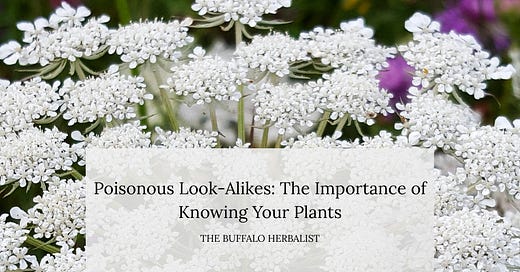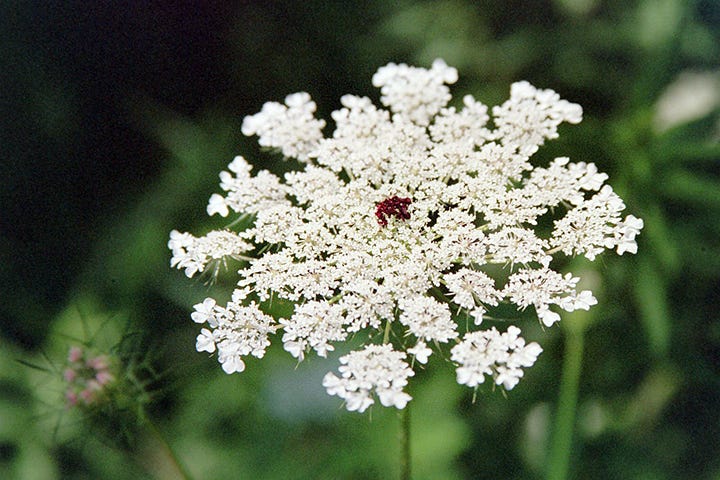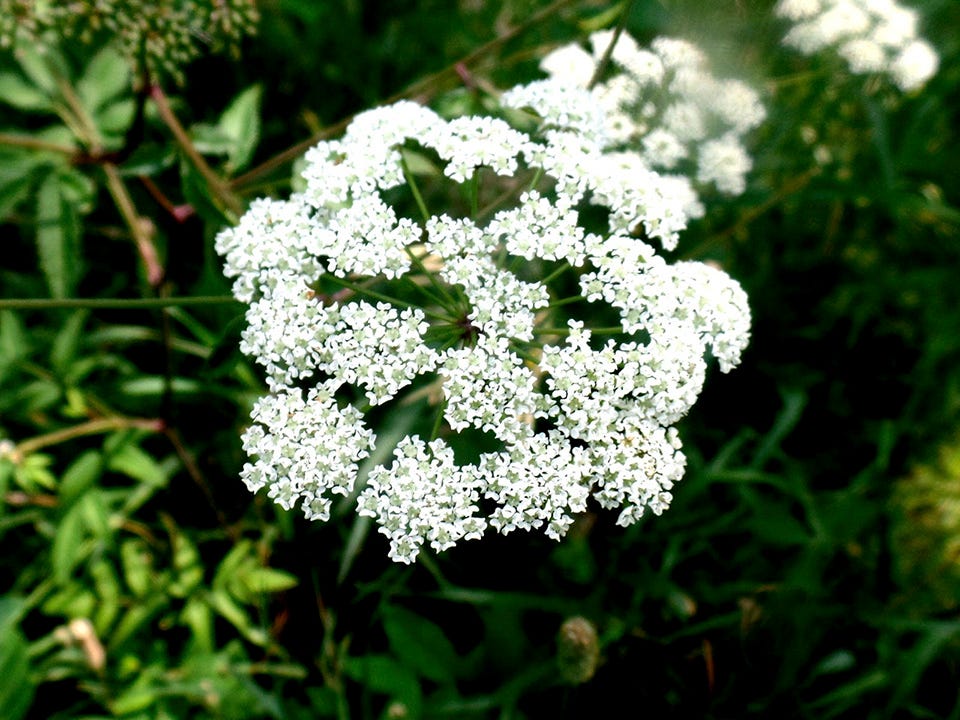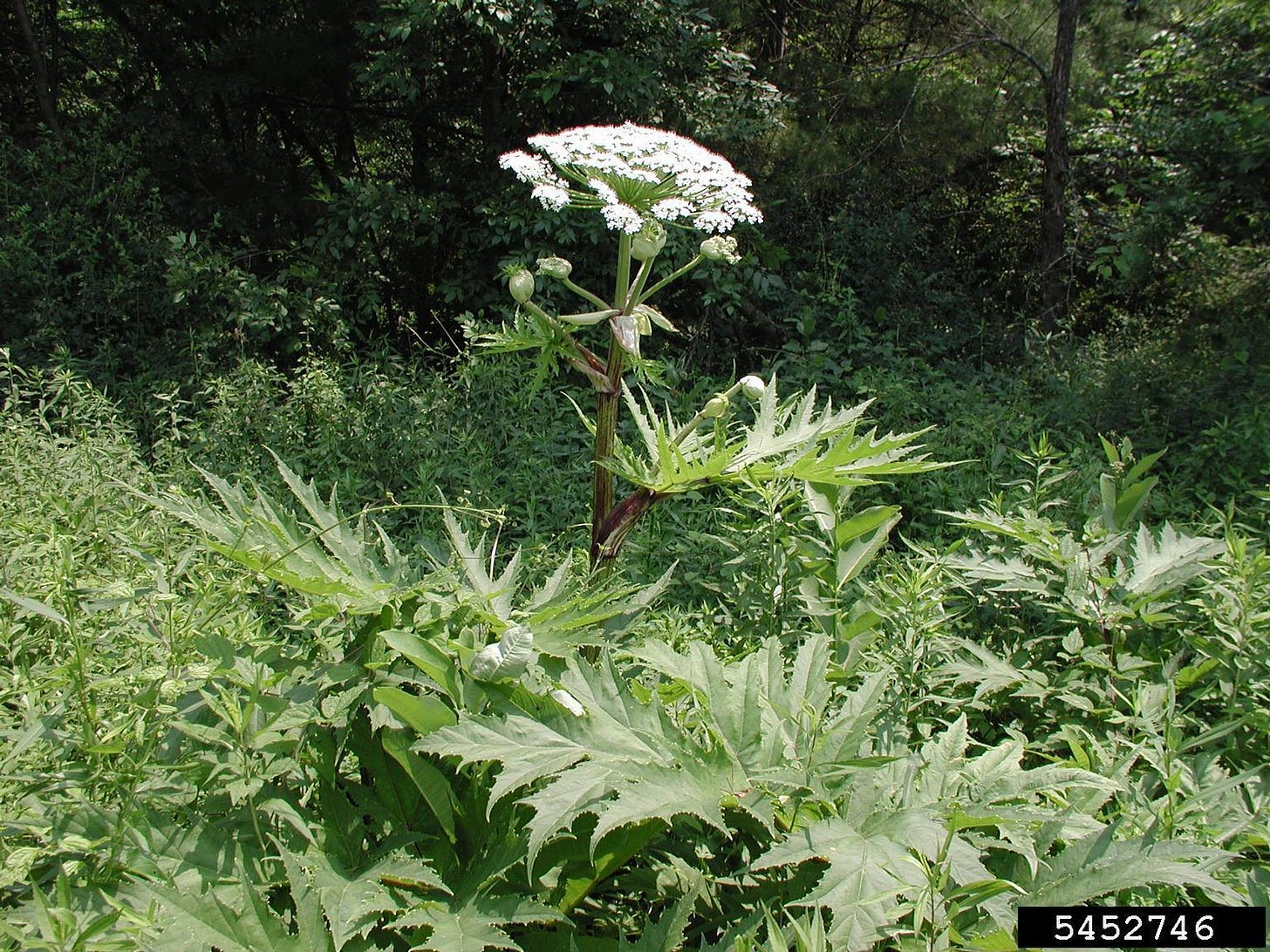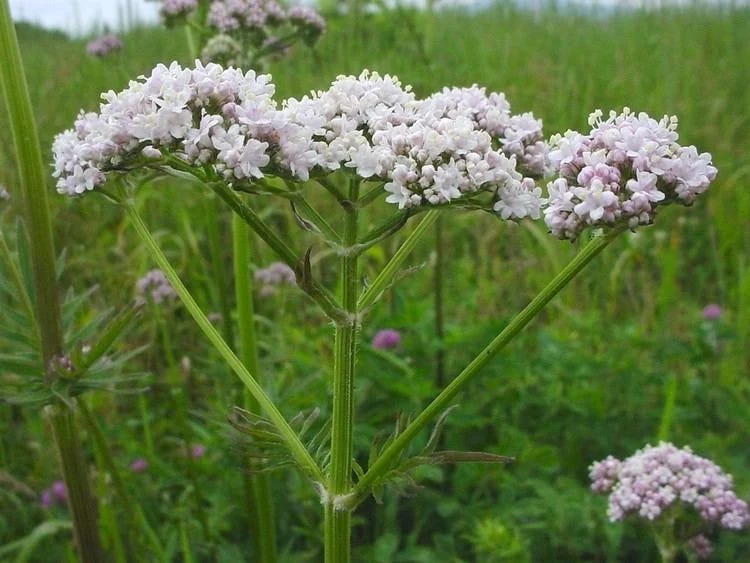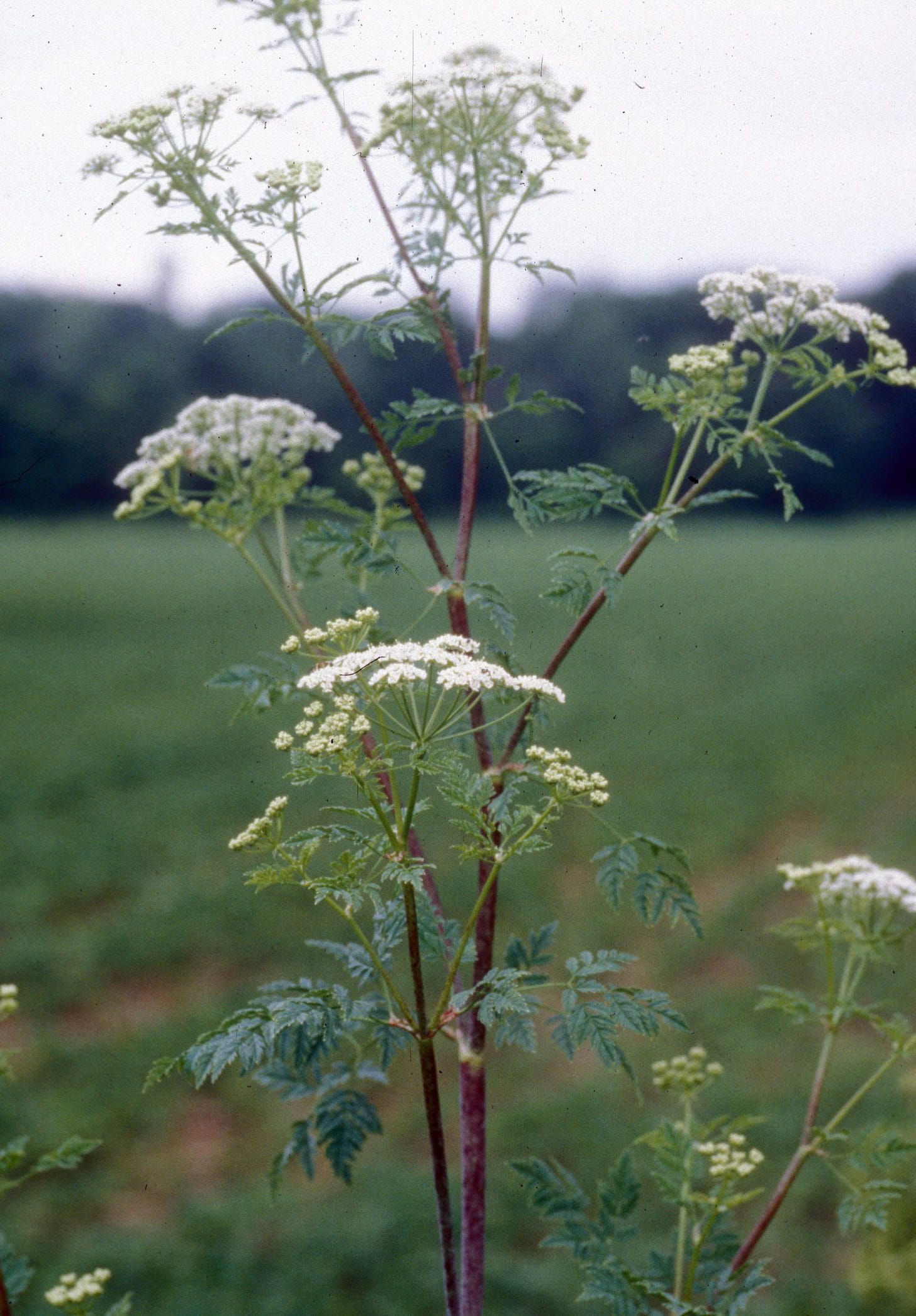Poisonous Look-Alikes: The Importance of Knowing Your Plants
how to safely identify medicinal herbs—and avoid their toxic look-alikes: a botanical guide to common confusions
Welcome to The Buffalo Herbalist’s first lesson in Botany. Please take your seats.
I was first introduced to this topic while enrolled at the Northern Appalachia Herbal School. It was given to us as an assignment—write about poisonous look-alikes. Being new to the herbal world, I was intrigued. I chose to write about umbels and umbel-like plants. Namely, Queen Anne’s Lace, the hemlocks, wild carrot, and yarrow.
Of course, to the seasoned forager or practicing herbalist, these can be easy enough to tell apart once you learn to look at the whole plant. But a lot of people stop their education at the flower. And most flowers shouldn’t really look that alike... right?
BUZZER SOUND ERRRR.
They really can look that similar. Enough so that it’s worth taking the time to learn the differences—and not just from a blurry Google image search.
I’ve also seen a recent push online recommending “natural” options for birth control, and Queen Anne’s Lace keeps getting mentioned. Personally, I wouldn’t rely on it for that purpose. But that’s a topic for another day. What matters more right now is that if you’re even thinking of foraging something like that, you really need to know what you’re looking at.
So, this is your friendly introduction to plant identification here at The Buffalo Herbalist. Let’s look at some of the plants that get mistaken for one another... and the risks that come with it.
And if this all feels overwhelming or isn’t quite clicking—don’t worry, I gotchu. For members of The Buffalo Herbalist Community, I’ve put together study notes and a mini “Know Your Umbels” guide to help keep everything straight and easy to reference. You’ll find them after the bibliography!

Queen Anne’s Lace vs. Water Hemlock
One smells like carrot. The other causes violent seizures. Know the difference.
This comparison might be even more dangerous than the last because Water Hemlock (Cicuta douglasii) is often overlooked by newer foragers. Like Queen Anne’s Lace (Daucus carota), it belongs to the carrot family and features delicate white umbels and fine, lacy leaves. But don’t let the resemblance fool you. While Queen Anne’s Lace offers an edible root in its first year and carries a bit of charming folklore, Water Hemlock is one of the most toxic plants in North America.
Both are biennials with similar life cycles. They produce a leafy rosette in the first year, then send up a flowering stalk in the second. They also share the signature umbel shape, with clusters of tiny flowers spreading out from a central point. That’s where the similarities end.
Water Hemlock contains cicutoxin, a powerful neurotoxin that interferes with GABA, the brain’s calming neurotransmitter. When GABA is blocked, the nervous system becomes overstimulated. The result is rapid-onset seizures, muscle tremors, and potentially respiratory failure. This isn’t a plant that just gives you a stomachache. It can kill you, and quickly.
Here’s how to tell the two apart.
Queen Anne’s Lace typically grows in dry areas like fields, pastures, and roadsides. Its flower heads are flatter and often, though not always, feature a single dark purple floret in the center. I was taught by another herbalist that this floret represents Queen Anne’s tear, said to have fallen onto her lace as she pricked her finger while stitching the flower into being. Tip: look for this floret for confirmation of plant ID!
At the base of the flower cluster, you’ll usually find bracts that resemble a bird’s nest—feathery and curled inward. The stem is hairy and solid, and the leaves look like finely divided carrot tops. When you crush the root, it smells distinctly like carrot.
Queen Anne's Lace
Water Hemlock, by contrast, prefers wet environments like marshes, stream banks, and soggy meadows. Its flower clusters are more rounded or dome-shaped and lack the central purple floret. It also does not have the same bird’s nest bracts underneath the flower. The stem is smooth, green, hollow, and hairless. The leaves are coarser, sharply toothed, and compound. When crushed, the plant emits a foul, almost chemical odor—nothing like the earthy sweetness of wild carrot. Most importantly, the root is thick, white, and filled with multiple internal chambers. This part of the plant is especially dangerous, and even small exposures can be fatal.
Water Hemlock (no red floret!)
If you’re not completely sure what you’re looking at, don’t harvest it. Relying on the flower alone isn’t enough. You need to observe the stem, the leaves, the smell, the location, and especially the root. These plants often grow near one another, so don’t assume proximity means safety.
Even touching Water Hemlock can be risky, especially if you have open cuts or accidentally transfer any part of the plant to your mouth or eyes. There is no antidote.
Queen Anne’s Lace is considered mildly toxic in large amounts due to compounds like furocoumarins, but it is nowhere near as dangerous. Still, if there’s any doubt, it’s always better to walk away.
Angelica vs. Giant Hogweed
One is a sweet-tasting herbal ally. The other can leave you with burns that last for years.
Angelica archangelica is a beautiful, towering member of the carrot family often found in cultivated gardens or growing wild in cool, northern climates. Traditionally used in European herbalism, this plant is known for its aromatic stems, roots, and seeds, all of which carry a sweet, slightly musky, licorice-like scent. Angelica is bold and stately, often reaching 5 to 6 feet in height, with large, pale green leaves and rounded, globe-shaped flower umbels in early summer.
Angelica
The entire plant is edible and medicinal in the right hands. It has a long-standing use in liqueurs, candies, and bitter digestive formulas. It’s a plant herbalists learn to love—but only when they know how to identify it correctly.
Because here’s the risk: giant hogweed (Heracleum mantegazzianum) grows even bigger and looks just similar enough to confuse new foragers. This invasive species can reach 12 to 15 feet tall, with deeply lobed leaves up to 5 feet across, and massive, flat-topped umbels of white flowers. The stem is hollow, ridged, and often blotched with purple. The purple is where I think people can get the most confused - and this goes both ways, purple doesn’t mean BAD but it also doesn’t mean GOOD. Look at the rest of the plant!
Giant Hogweed
Unlike angelica, giant hogweed is phototoxic. The sap contains furanocoumarins, chemical compounds that can cause severe skin burns when exposed to sunlight. Blisters may appear within 24 to 48 hours and can leave lasting dark scars. If the sap gets into the eyes, it may lead to temporary or permanent vision loss. Even brushing against the plant on a sunny day can be enough to trigger a reaction.
Key Differences
Flower structure: Angelica’s umbels are rounded and compact. Hogweed’s are wide, flat, and spread out like a dinner plate.
Scent: Angelica has a sweet, herbal, licorice-like aroma. Hogweed has little to no scent.
Stem: Angelica stems may be reddish and smooth, with inflated leaf bases. Giant hogweed stems are heavily ridged and marked with purple blotches, often with coarse white hairs at the nodes.
Leaf shape: Angelica has compound, serrated leaves but they’re not as huge or as deeply lobed as hogweed’s.
Height: Angelica may reach 5–6 feet. Giant hogweed can tower at 10–15 feet tall.
If you’re wildcrafting angelica or anything in the carrot family, especially near water or in disturbed areas, double-check your ID. Avoid harvesting in bright sun, and don’t rely on just one feature. When it comes to hogweed, it’s better to admire from a distance.
Valerian vs. Poison Hemlock
Two tall plants with white flowers. One soothes the nervous system. The other shuts it down.
Valeriana officinalis is a well-loved plant in Western herbalism, used to calm anxiety, ease tension, and support deep sleep. It grows upright, usually between 3 to 5 feet tall, with finely divided leaves and small white to pale pink flowers clustered in branching heads. The scent of the root is... unmistakable. Some call it earthy, others call it funky, I call it gym socks, but either way, it’s one of the easiest ID tools when working with valerian.
The leaves are pinnate, soft, and often compared to elder or fern leaves. It blooms from mid to late summer and prefers damp meadows, woodland edges, or even higher ground in northern climates.
Unfortunately, valerian is sometimes confused with poison hemlock (Conium maculatum), a plant that shares similar foliage and also grows tall with clusters of tiny white flowers. And while valerian has a long history as a gentle sedative, poison hemlock is lethal. All parts of the plant contain coniine, an alkaloid that acts as a neurotoxicant, causing progressive muscle paralysis and respiratory failure.
Valerian
Key Differences
Stem: Poison hemlock stems are hairless, hollow, and often streaked or blotched with purple. Valerian stems are generally green, hollow, and may have soft hairs.
Leaves: Both have divided leaves, but valerian’s are often broader and softer, while hemlock’s are finer, more parsley-like, and often confused with carrot tops.
Flowers: Valerian’s flowers are arranged in loose, domed clusters and often have a slight pink tint. Poison hemlock’s are flat-topped, bright white, and form a more classic umbel shape.
Smell: Valerian root has a strong, pungent smell that you won’t forget. Hemlock has no distinct root scent, and sometimes a musty green smell.
Height: Both can grow tall, but poison hemlock can reach 8 feet in rich soil and spreads aggressively along roadsides and wet ditches.
Poison Hemlock
The confusion usually happens when someone sees the leaf shape first, especially early in the season before the flowers and root scent help clarify things. If you’re harvesting valerian in the wild, don’t rely on a single visual feature. Always cross-reference the stem, flower, leaf, and root—and if you’re even a little unsure, skip it.
While these classic comparisons highlight some of the most dangerous mix-ups, they’re not the only ones worth mentioning. Even some of our most trusted plant allies—like elderberry and yarrow—share enough visual similarities with toxic plants to give pause.
So, before we wrap up, let’s take a closer look at these two beloved herbs, and what you should know when identifying them in the wild.
Elderberry (Sambucus nigra ssp. cerulea)
Elder is generous in every sense—branches, berries, blossoms, medicine, and myth. The species you’ll find most often in western North America is Sambucus nigra ssp. cerulea, sometimes called blue elder or western elderberry. It’s part of the honeysuckle family, though elder has a long herbal tradition all its own.
This deciduous shrub can grow between 6 to 20 feet tall and tends to take on a loose, somewhat sprawling shape. Young twigs are soft and pithy, while mature wood becomes tough and ridged with age. The bark is thin and greyish-brown, often furrowed as the plant matures.

The leaves are arranged oppositely along the stem and are pinnately compound—meaning each leaf is made up of multiple leaflets, typically 5 to 9 per leaf. These leaflets have serrated edges and can grow up to 6 inches long. If you’re working with a seedling or non-flowering plant, be cautious: young elder leaves can resemble Oregon ash or even black walnut, so it’s important to confirm identification with multiple features.
In early to midsummer, elderberry produces broad, flat-topped clusters of creamy white flowers with a subtle fragrance—pleasant to some, a little funky to others. These blossoms are not only used in medicine but also in cordials, syrups, and traditional skincare preparations.
By late summer, the plant yields drooping clusters of blue-black berries, covered in a powdery white bloom that gives them a dusty or powder-blue appearance. These berries are rich in flavonoids and have been traditionally used to support immune health and recovery from colds and flu. Raw berries and other parts of the plant can be mildly toxic, so they’re typically cooked or processed before consumption.
Elderberry prefers moist, well-drained soil and sunny conditions. It’s commonly found along streambanks, in canyons, at the edges of forests, and in open clearings across the western U.S. It grows at elevations below 3,000 meters and is especially fond of riparian habitats.
In folklore, elder was considered sacred, protected by spirits, and never cut without permission or offering. In practice, it remains one of the most giving and well-loved plants in herbal medicine.
Yarrow (Achillea millefolium)
Yarrow is one of those hardy, loyal plants that shows up almost anywhere — meadows, mountains, roadside ditches, and even along dry forest edges. It’s a perennial forb that typically grows upright to about 1 to 3 feet tall, with unbranched stems covered in woolly, gray-green hairs that give the whole plant a soft, silvery appearance.
The leaves are deeply divided and fern-like, giving yarrow its signature feathery look. They're narrow, lance-shaped, and alternate up the stem on short petioles. Depending on the environment, whether it’s high elevation or desert terrain, yarrow can grow thicker with more abundant leaves, forming a denser appearance overall. The plant also spreads by rhizomes, creating tight colonies that can blanket whole patches of land.

Yarrow’s flower heads are flat-topped clusters made up of tiny ray and disk florets. Most are white, though soft pink or pale lavender varieties sometimes appear. Each flower cluster measures about half an inch to an inch across and can hold anywhere from 10 to 100 blooms. These flowers emerge in late spring and often last until early fall, especially in cooler climates. One detail I love to point out is that some flowers have a single dark purple floret in the center, which I was taught by another herbalist is called Queen Anne’s tear.

Yarrow thrives in open, sunny areas with well-drained soil and can be found growing from sea level all the way up to 11,000 feet in elevation. It's one of the most widely distributed native flowering plants in the western U.S., and it adapts to a wide range of habitats, from grasslands and pastures to alpine ridges and sagebrush scrub.
In terms of energetics, it’s cooling and drying and has historically been used as a wound herb, fever support, and digestive bitter. But even if you’re not working with it medicinally, yarrow is worth learning to recognize. Once you do, you’ll start noticing it everywhere — and it’s hard not to smile when you do.
Learning to identify plants is more than just an herbalist’s hobby—it’s a form of respect. It’s how we keep ourselves safe, how we deepen our connection to the land, and how we begin to notice the stories growing all around us.
The plants don’t always make it easy. Some look nearly identical. Some hide their traits until you get close enough to notice the scent, the stem, the way the leaves alternate just so. But that’s part of the practice. We slow down, we pay attention, and we build a relationship based on more than guesswork and Google images.
If you’re new to plant ID, I hope this gave you a solid place to start. And if you’ve been doing this for a while, maybe it was a good refresher. Either way, the message is the same: don’t rely on flowers alone. Look at the whole plant. Ask questions. Don’t harvest what you can’t name with confidence.
I’ve put together a set of printable guides, comparison charts, and helpful ID tips for paid subscribers who want to take this lesson into the field. If you found this post helpful and want to go deeper, consider joining us there. Your support keeps this work going and helps me share more plant wisdom with those who need it most. As always, you’ll find these resources after the references.
This week will be materia medica heavy. I’ll cover majority of the plants mentioned here today. Get your notebooks ready!
Until then, happy foraging, and keep your eyes open. Plants are speaking all around us. We just have to learn how to listen.
-Agy | The Buffalo Herbalist

Bibliography
USDA NRCS National Plant Data Center & Biota of North America Program. (1968). COMMON ELDERBERRY: Sambucus nigra L. ssp. canadensis (L.) R. Bolli. In National Plant Data Center. https://www.nrcs.usda.gov/plantmaterials/mipmcpg9776.pdf
USDA-NRCS. (n.d.). COMMON YARROW. https://www.nrcs.usda.gov/plantmaterials/mtpmcpg13974.pdf
A modern herbal | Valerian. (n.d.). https://www.botanical.com/botanical/mgmh/v/valeri01.html
Angelica archangelica - Plant Finder. (n.d.). https://www.missouribotanicalgarden.org/PlantFinder/PlantFinderDetails.aspx?kempercode=e399
Carter, H. (2023, August 10). Poison Hemlock Guide: What it Looks Like & How to Get Rid of It from Your Garden. GardenBeast. https://gardenbeast.com/poison-hemlock-guide/
Water hemlock (Cicuta douglasii) : USDA ARS. (n.d.). https://www.ars.usda.gov/pacific-west-area/logan-ut/poisonous-plant-research/docs/water-hemlock-cicuta-douglasii/
Giant Hogweed | Cornell Weed Identification. (n.d.). https://blogs.cornell.edu/weedid/giant-hogweed/
Wilson, J. (2024, April 10). Water Hemlock vs Queen Anne's Lace: How To Tell The Difference - Botany-World. Botany World. https://botany-world.com/water-hemlock-vs-queen-annes-lace/
Members of The Buffalo Herbalist Community can find their exclusive botanical guides here:
Keep reading with a 7-day free trial
Subscribe to The Buffalo Herbalist to keep reading this post and get 7 days of free access to the full post archives.


